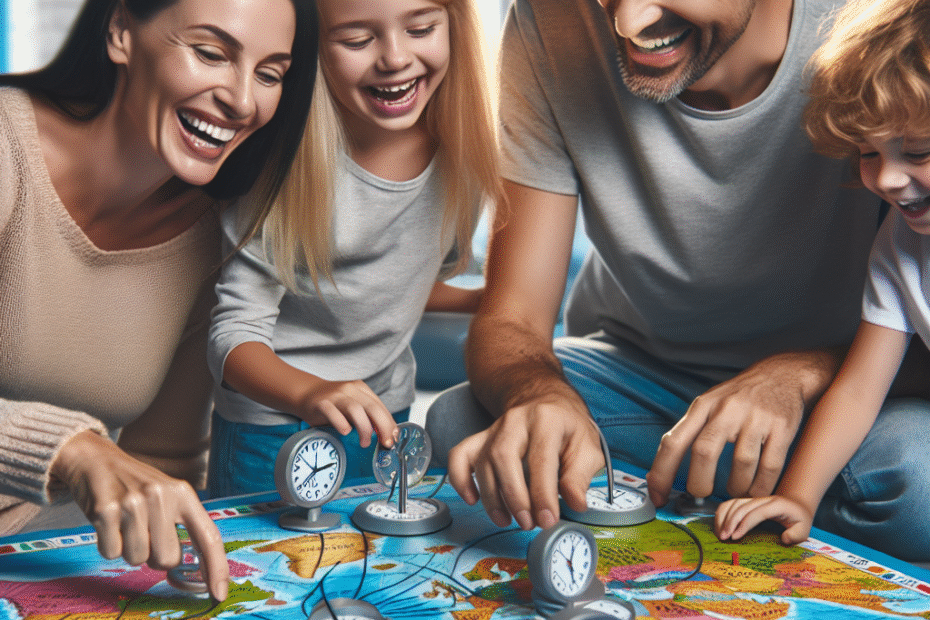“`html
Fun Ways to Teach Kids About Time Zones and World Clocks
Understanding time zones and world clocks can be challenging for kids. It’s a concept that connects geography with the daily act of reading the time, yet many find it difficult to grasp. Studies indicate that spatial reasoning significantly improves when children engage with subjects like time zones. According to a report by the National Center for Education Statistics, approximately 31% of children struggle with time-telling skills. Learning about time zones can be a playful yet educational experience, which could improve these skills. This blog shares creative ways to make this topic engaging for young learners.
Key Takeaways
- Interactive activities and immersive experiences enhance understanding of time zones for kids.
- Using tools like world clocks and time zone apps can make learning more engaging.
- Linking time zones to global cultural events helps in retaining the information better.
Games and Interactive Activities
Children love games, and educational games can be particularly effective in teaching new concepts. One fun idea is to create a “Time Zone Treasure Hunt.” Kids can be given clues that lead them to different time zones, either digitally or with physical locations marked out in a classroom. At each location, they “unlock” facts about that time zone, such as the number of hours ahead or behind it is compared to their local time.
World Clock Puzzle: Another engaging activity is a world clock puzzle. This could involve matching clocks showing different times with their corresponding time zones or countries. The tactile experience of putting together a puzzle helps solidify the information as children engage multiple senses during the activity.
Digital Tools and Resources
Digital tools can complement traditional learning methods. Several apps are designed specifically to teach kids about time zones. Apps like “World Clock Time Zone Converter” simulate real-world applications, allowing them to be global time travelers from the comfort of their homes. They can input any city in the world and instantly see the local time, learning the differences by direct interaction.
A website like TimeAndDate.com provides an easy-to-understand interface with a world clock map. Children can visually explore which countries fall into different time zones and see the immediate impact on the world map when they change the time.
Linking Time Zones to Cultural Events
Linking time learning to cultural events can play a pivotal role in deeper understanding. For instance, when watching ceremonies like the Olympics or New Year celebrations in different countries, parents can ask children to convert those times back into their local time. Understanding global news becomes an engaging experience, shifting from an abstract concept to a tangible event.
Classroom Role Play
One effective classroom strategy is role play. Instructors can assign different countries or regions to students, and they have to plan an event in their respective time zones. A class-wide meeting can then demonstrate how these events line up with one another, underscoring the differences between time zones and the connections they form.
Tables and Visual Aids
Visual aids are crucial when explaining abstract concepts like time zones. Here’s a simple table showing the major world time zones with examples of countries within those zones:
| Time Zone | UTC Offset | Example Countries |
|---|---|---|
| Eastern Standard Time (EST) | UTC-5 | USA, Canada (East Coast) |
| Greenwich Mean Time (GMT) | UTC+0 | UK, Portugal |
| Central European Time (CET) | UTC+1 | Germany, France |
| Japan Standard Time (JST) | UTC+9 | Japan, South Korea |
Tables like these offer visual reinforcement for children, relating each time zone to proper geographical contexts and showing how these differences manifest in everyday life.
FAQ Section
- What are time zones?
Time zones are regions of the Earth that have the same standard time. They are important for keeping a consistent time frame across different areas. - Why do we have time zones?
The Earth is divided into 24 time zones based on its rotation, allowing different parts of the world to maintain a uniform time according to their position relative to the sun. - How many time zones are there?
There are 24 main time zones in the world. However, more zones exist due to some regions using 30 or 45-minute offsets. - Can time zones change?
Yes, some regions observe daylight saving time which can temporarily change the standard time of a region, and countries can alter their time zone due to socio-political reasons. - What is the most important time zone?
Greenwich Mean Time (GMT) is often considered a reference point for other time zones and is critical for standardized global time.
Providing children with enjoyable and interactive ways to learn about time zones and world clocks not only enriches their education but also enhances their spatial and time-telling skills. With the incorporation of digital tools, engaging games, and real-world applications, the learning experience can be both enlightening and fun.
“`
